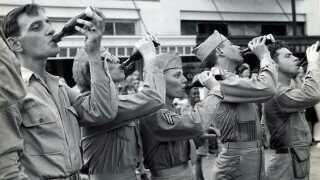Before The 'Cola Wars,' Coca-Cola Was On The Frontlines Of WWII

American GIs in World War II did not get to experience many creature comforts. Sustained mostly by C-Rations and whatever could be made in a field kitchen, troops were halfway around the world from the tastes of home. There was one exception. Every serviceman had access to a supply of Coca-Cola. This was done through a global network of bottling plants, technological innovations, and an entire unit whose job was to ensure that soda supplies never ran dry.
In 1943, Dwight Eisenhower sent a request to the head of Coca-Cola. Eisenhower requested 10 portable Coca-Cola factories near the frontlines. This came after Coke President Robert Woodruff had previously stated that any American servicemen would be able to get a Coke during the war no matter what it cost the company. With a request from Eisenhower, it was time for the soda producer to put up or shut up, and they came through with a plan that far exceeded the original 10 factories.

64 Coca-Cola bottling facilities were made for the war effort. These would not have been as successful as they were, though, without the aid of the Technical Observers. This might sound like an obscure military rank, and it sort of was. What the Technical Observers (or TOs) really were were Coca-Cola representatives uniformed in fatigues who were tasked with ensuring that GIs had Coke available to them regardless of where they were. 148 TOs helped quench the thirst of servicemen.
Don't Miss
Coke’s campaign to give troops everywhere their soda fix spread across the globe, but they did encounter issues in the Pacific. While the efforts to build bottling plants were successful, it was harder to get to more remote areas. There was a solution, though: jungle fountains. These were soda fountains, which were not common yet, that could be transported anywhere easier than bottles could. 1,100 jungle fountains were produced to aid in the war on thirst.
In a modern cynical view, the whole Coca-Cola ordeal could come off as a marketing stunt, and it is no secret that the company did take advantage of the good publicity it gave them. Coke ads from the time showed GIs sharing Cokes with other Allies, which helped to spread the brand globally.
The effort did accomplish its mission of boosting troop morale, though. It is not hard to find accounts from troops excited about having access to Coca-Cola. In times of chaos, something as simple as a familiar sugary soft drink did a lot of good, and Coke did its part by providing GIs with more than 5 billion sodas. Which means that chugging carbonated sugar water while playing Call of Duty: WWII makes the game more historically accurate.
Top Image: rich701/Creative Commons